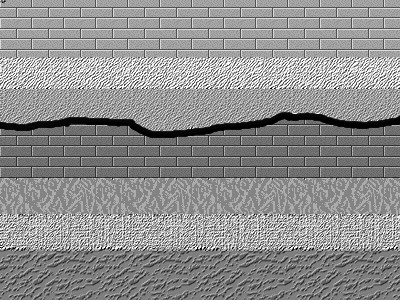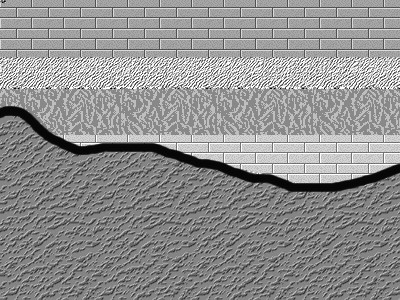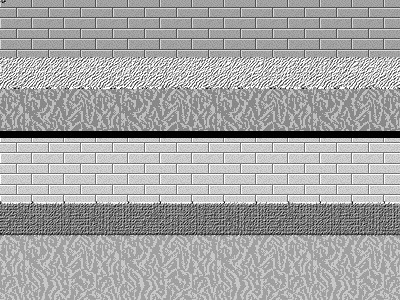unconformity on:
[Wikipedia]
[Google]
[Amazon]
 An unconformity is a buried erosional or non-depositional surface separating two rock masses or strata of different ages, indicating that
An unconformity is a buried erosional or non-depositional surface separating two rock masses or strata of different ages, indicating that
 A disconformity is an unconformity between parallel layers of sedimentary rocks which represents a period of erosion or non-deposition. Disconformities are marked by features of subaerial erosion. This type of erosion can leave channels and paleosols in the rock record.
A disconformity is an unconformity between parallel layers of sedimentary rocks which represents a period of erosion or non-deposition. Disconformities are marked by features of subaerial erosion. This type of erosion can leave channels and paleosols in the rock record.
 A nonconformity exists between sedimentary rocks and
A nonconformity exists between sedimentary rocks and
 An angular unconformity is an unconformity where horizontally parallel strata of sedimentary rock are deposited on tilted and eroded layers, producing an angular discordance with the overlying horizontal layers. The whole sequence may later be deformed and tilted by further
An angular unconformity is an unconformity where horizontally parallel strata of sedimentary rock are deposited on tilted and eroded layers, producing an angular discordance with the overlying horizontal layers. The whole sequence may later be deformed and tilted by further
 A paraconformity is a type of unconformity in which the sedimentary layers above and below the unconformity are parallel, but there is no obvious erosional break between them. A break in sedimentation is indicated, for example, by fossil evidence. It is also called nondepositional unconformity or pseudoconformity. Short paraconformities are called
A paraconformity is a type of unconformity in which the sedimentary layers above and below the unconformity are parallel, but there is no obvious erosional break between them. A break in sedimentation is indicated, for example, by fossil evidence. It is also called nondepositional unconformity or pseudoconformity. Short paraconformities are called
File:Disconformity Horni Pocernice.jpg, ''Disconformity'' at
 An unconformity is a buried erosional or non-depositional surface separating two rock masses or strata of different ages, indicating that
An unconformity is a buried erosional or non-depositional surface separating two rock masses or strata of different ages, indicating that sediment
Sediment is a naturally occurring material that is broken down by processes of weathering and erosion, and is subsequently transported by the action of wind, water, or ice or by the force of gravity acting on the particles. For example, sa ...
deposition was not continuous. In general, the older layer was exposed to erosion for an interval of time before deposition of the younger layer, but the term is used to describe any break in the sedimentary
Sedimentary rocks are types of rock that are formed by the accumulation or deposition of mineral or organic particles at Earth's surface, followed by cementation. Sedimentation is the collective name for processes that cause these particles ...
geologic record
The geologic record in stratigraphy, paleontology and other natural sciences refers to the entirety of the layers of rock strata. That is, deposits laid down by volcanism or by deposition of sediment derived from weathering detritus (clays, sand ...
. The significance of angular unconformity (see below) was shown by James Hutton, who found examples of Hutton's Unconformity at Jedburgh in 1787 and at Siccar Point in 1788.
The rocks above an unconformity are younger than the rocks beneath (unless the sequence has been overturned). An unconformity represents time
Time is the continued sequence of existence and events that occurs in an apparently irreversible succession from the past, through the present, into the future. It is a component quantity of various measurements used to sequence events, ...
during which no sediments were preserved in a region or were subsequently eroded before the next deposition. The local record for that time interval is missing and geologists must use other clues to discover that part of the geologic history of that area. The interval of geologic time not represented is called a hiatus. It is a kind of relative dating
Relative dating is the science of determining the relative order of past events (i.e., the age of an object in comparison to another), without necessarily determining their absolute age (i.e., estimated age). In geology, rock or superficial dep ...
.
Types
Disconformity
 A disconformity is an unconformity between parallel layers of sedimentary rocks which represents a period of erosion or non-deposition. Disconformities are marked by features of subaerial erosion. This type of erosion can leave channels and paleosols in the rock record.
A disconformity is an unconformity between parallel layers of sedimentary rocks which represents a period of erosion or non-deposition. Disconformities are marked by features of subaerial erosion. This type of erosion can leave channels and paleosols in the rock record.
Nonconformity
 A nonconformity exists between sedimentary rocks and
A nonconformity exists between sedimentary rocks and metamorphic
Metamorphic rocks arise from the transformation of existing rock to new types of rock in a process called metamorphism. The original rock (protolith) is subjected to temperatures greater than and, often, elevated pressure of or more, causi ...
or igneous rocks when the sedimentary rock lies above and was deposited on the pre-existing and eroded metamorphic or igneous rock. Namely, if the rock below the break is igneous or has lost its bedding due to metamorphism, the plane of juncture is a nonconformity.
Angular unconformity
 An angular unconformity is an unconformity where horizontally parallel strata of sedimentary rock are deposited on tilted and eroded layers, producing an angular discordance with the overlying horizontal layers. The whole sequence may later be deformed and tilted by further
An angular unconformity is an unconformity where horizontally parallel strata of sedimentary rock are deposited on tilted and eroded layers, producing an angular discordance with the overlying horizontal layers. The whole sequence may later be deformed and tilted by further orogenic
Orogeny is a mountain building process. An orogeny is an event that takes place at a convergent plate margin when plate motion compresses the margin. An ''orogenic belt'' or ''orogen'' develops as the compressed plate crumples and is uplifted t ...
activity. A typical case history is presented by the paleotectonic evolution of the Briançonnais realm (Swiss and French Prealps) during the Jurassic.
Paraconformity
 A paraconformity is a type of unconformity in which the sedimentary layers above and below the unconformity are parallel, but there is no obvious erosional break between them. A break in sedimentation is indicated, for example, by fossil evidence. It is also called nondepositional unconformity or pseudoconformity. Short paraconformities are called
A paraconformity is a type of unconformity in which the sedimentary layers above and below the unconformity are parallel, but there is no obvious erosional break between them. A break in sedimentation is indicated, for example, by fossil evidence. It is also called nondepositional unconformity or pseudoconformity. Short paraconformities are called diastem In geology, a diastem (plural: diastems) is a short interruption in sedimentation with little or no erosion. They can also be described as very short unconformities (more precisely as very short paraconformities).In 1917 Joseph barrel of USA estim ...
s.
Buttress unconformity
A buttress unconformity also known as onlap unconformity, occurs when younger bedding is deposited against older strata thus influencing its bedding structure.Blended unconformity
A blended unconformity is a type of disconformity or nonconformity with no distinct separation plane or contact, sometimes consisting of soils,paleosol
In the geosciences, paleosol (''palaeosol'' in Great Britain and Australia) is an ancient soil that formed in the past. The precise definition of the term in geology and paleontology is slightly different from its use in soil science.
In geolo ...
s, or beds of pebbles derived from the underlying rock.
Gallery
Horni Pocernice
Prague 20, also known as Horní Počernice (German ''Ober Potschernitz''), is a municipal district (''městská část'') in Prague. It is located in the eastern part of the city. It is formed by one cadastre Horní Počernice. , there were 15,404 ...
, Czech Republic
File:Borden-Sharon unconformity.jpg, ''Disconformity'' (at the hammer) between underlying Mississippian Borden Formation and overlying Pennsylvanian Sharon Conglomerate, near Jackson, Ohio
Jackson is a city in and the county seat of Jackson County, Ohio, United States approximately 27 mi (43 km) SE of Chillicothe. The population was 6,239 at the 2020 census.
History
Established in 1817, residents named the to ...
File:Taum Sauk precambrian-cambrian unconformity.jpg, There is a billion-year gap in the geologic record where this 500-million-year-old dolomite ''nonconformably'' overlies 1.5-billion-year-old rhyolite, near Taum Sauk Hydroelectric Power Station, Missouri.
File:Ratssteinbruch Dresden-Doelzschen.jpg, ''Nonconfirmity'' at Ratssteinbruch near Dresden
Dresden (, ; Upper Saxon: ''Dräsdn''; wen, label= Upper Sorbian, Drježdźany) is the capital city of the German state of Saxony and its second most populous city, after Leipzig. It is the 12th most populous city of Germany, the fourth ...
, Germany
File:Siccar Point red capstone closeup.jpg, Hutton's ''angular unconformity'' at Siccar Point where 345-million-year-old Devonian Old Red Sandstone
The Old Red Sandstone is an assemblage of rocks in the North Atlantic region largely of Devonian age. It extends in the east across Great Britain, Ireland and Norway, and in the west along the northeastern seaboard of North America. It also exte ...
overlies 425-million-year-old Silurian greywacke
Greywacke or graywacke (German ''grauwacke'', signifying a grey, earthy rock) is a variety of sandstone generally characterized by its hardness, dark color, and poorly sorted angular grains of quartz, feldspar, and small rock fragments or lit ...
File:Angular Unconformity at Praia do Telheiro in Algarve in Portugal.png, ''Angular unconformity'' of Triassic
The Triassic ( ) is a geologic period and system (stratigraphy), system which spans 50.6 million years from the end of the Permian Period 251.902 million years ago (Year#Abbreviations yr and ya, Mya), to the beginning of the Jurassic Period 201.36 ...
rocks overlying steeply-tilted Carboniferous rocks at Praia do Telheiro, Portugal
File:Steamboat Butte New Mexico.jpg, ''Angular unconformity'' between the underlying Dockum Group
The Dockum is a Late Triassic (approximately late Carnian through Rhaetian, or 223–200 Ma) geologic group found primarily on the Llano Estacado of western Texas and eastern New Mexico with minor exposures in southwestern Kansas, eastern Colora ...
and the overlying Exeter Sandstone at Steamboat Butte in the valley of the Dry Cimmarron, New Mexico
File:Winkeldiskordanz.JPG, Angular unconformity in Jingtai County, China
References
Further reading
* U.S. Bureau of Mines Dictionary of Mining, Mineral, and Related Terms published on CD-ROM in 1996. {{Authority control Historical geology Stratigraphy +